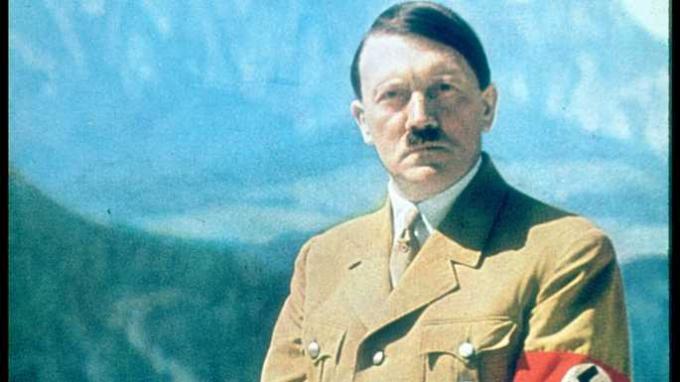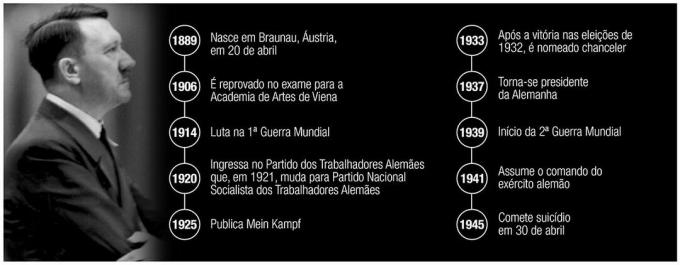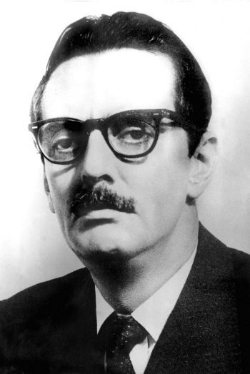adolf hitler (1889-1945) was an Austrian-born politician and dictator who ruled Germany from 1933 to 1945.
He gained power by democratic means and led the process that culminated in the Second World War (1939-1945), where 56 million people died.
Adolf Hitler Biography

Born April 20, 1889 in the city of Braunau am Inn, Austria, Adolf was the fourth child of Alois Schickelgruber and Klara Hitler.
His father was a customs official known for his strict temper with his children. His mother was a housewife. They had six children, but only two would reach adulthood.
The Hitler couple moved to the city of Passau, Germany, when Adolf was three years old. From there, they migrated to an agricultural community located in Hafeld.
In 1900, he already expressed a preference for drawing and painting, and Hitler was noted for his good performance at school. His grades made him eligible to take the Realshule (equivalent to the entrance exam), but the result was not satisfactory.
Back in Vienna, in 1906, three years after his father's death from a pleural effusion, Adolf Hitler tried to enter the Academy of Arts. He failed the entrance exam and dropped out of school because of poor results.
The following year, his mother died of breast cancer. The treatment, carried out by the Jewish physician Edward Bloch, was not successful. Alone, he remained for six years in Vienna, having as a means of support the pension left by his father.
He ran out of money in 1909 and slept in bars, homeless shelters and tenements. According to historians, this period was fundamental for the formation of anti-Semitic thought, interest in politics and the awakening of oratory skills.
Vienna was at that time an important center for the emergence of new ideas such as psychoanalysis, but also of socialism and the anti-Semitic discourse that would have fascinated Hitler.
Personal life
Little is known about the family and sentimental life of the would-be German leader. The only surviving sister, Paula, had little contact with him after the founding of the Nazi party and died without leaving any offspring.
Hitler declared that he was married to Germany and therefore could not enter into marriage. He had a romantic relationship with Eva Braun from the 1930s until her death in 1945.

First World War
The future German leader tried to avoid Austrian military service by moving to Munich in 1913. However, he ended up voluntarily joining the Bavarian army when he started to First World War (1914-1918). He was 25 years old.
The outcome of the First World War caused Germany despair and would be no different for Hitler.
The Germans left the conflict humiliated, the monarchy came to an end and the Republic was declared. The new constitution provided for a president with extensive military and political power under a parliamentary democracy.
In the election, 423 deputies were elected to the National Assembly in what became known as the Weimar Republic.
Germany then ratified the Treaty of Versailles on July 28, 1919, and thus the country had to pay for all civil damages caused in the war.
The Germans lost part of the territory and their colonies. They were also to demilitarize a 48 km strip on the right bank of the River Rhine.
Furthermore, they had to accept the limitation of their armed forces. All terms were considered humiliating for Germany.
German Workers' Party
At the end of the war, Adolf Hitler meets the Deutsch Arbeiterpartei (German Workers' Party). The precepts of the extreme right-wing legend seduced him and pointed to a way to achieve his political goals.
The party, which previously had few members, grew out of Hitler's fiery nationalist and anti-Semitic speeches.
An imposing speaker, he presented hypnotic ideas that drew, first hundreds and then thousands of participants and partisan donors.
Likewise, he attracted part of the middle and upper classes, who saw in his ideas the opportunity to regain their former prestige.
The military was interested in its eagerness to expand German territory and avenge itself for the defeat suffered in the First War.
Jews
On February 24, 1920, at a public meeting that brought together 2,000 participants, Hitler presented his 25 Theses. Among them were:
- the demand for the government to repeal the Treaty of Versailles;
- the confiscation of war profits;
- the expropriation of the Jews' lands, the revocation of their political rights and their expulsion from Germany.
Hitler blamed the Jews for the political instability, unemployment, inflation and the humiliation of war experienced by the Germans.
Under this climate, the name of the subtitle was changed in 1921 to Nationalsozialistische Deutsche Arbeiterpartei (National Socialist German Workers Party - NSDAP). The contraction of the first name, forms the abbreviation "Nazi" and where the words come from Nazism and Nazi.
Hitler's speech was no longer restricted to party meetings and he buys a newspaper to spread his ideas.
The Nazi party is favored by the desperation of the Germans, hyperinflation and unemployment driving thousands of people to join the NSDAP.
Putsch from munich
In 1923, the Weimar Republic is accused by the National Socialists of leaning towards leftist ideas. Hitler held a rally in a Munich brewery in November of the same year, where he intended to take over the Bavarian government and from there, march on Berlin. This episode would be known as the Putsch of Munich (Munich Coup).
However, local police invade the brewery and end the attempted coup. Hitler and several co-religionists are arrested on charges of treason and sentenced to five years in prison. However, nine months later, he is pardoned.
Mein Kampf - My Fight
During the time he was imprisoned, Adolf Hitler writes Mein Kampf (Minha Luta), a work in which he details his views on the future of the German people.
In the book, Hitler attacks Democrats, Communists and, above all, Jews, stressing that they were the enemies of the German nation.
According to Hitler, the Jews would be parasites without their own culture and who did not constitute a race. The German people, of the highest racial purity, would be a superior race and should avoid marriage with subhuman races, including Jews and Slavs.
Thus, it was up to Germany to eliminate the Jews from its own territory and expand into Russia. In this way an empire would be constituted (reich) that would last a thousand years under the command of a leader (Fuhrer).
These were also the ideas that guided the second edition of Mein Kampf, released in 1927. The book also featured the history of the Nazi Party and sold 5 million copies.
Hitler's ideas led the Nazi Party to win 33 percent of the vote in the 1930 constitutional elections. A political agreement led him to the post of chancellor in 1933, under the presidency of Paul von Hindenburg (1847-1934).
Second World War
After the president's death in 1934, Hitler succeeded him and would accumulate the two posts as president and prime minister of Germany.
In 1933 and 1934 he began to put into practice the ideas described in Mein Kampf enacting the first anti-Semitic laws. These would remove Jews from public service and restrict their access to education, among other measures.
During this period, he approaches and gains a partner in Benito Mussolini, Italian Prime Minister and creator of the fascism. Both will be allies during the war.
In 1937, Germany annexed Austria to its territory. On September 1, 1939, the German army invades Poland, starting the Second World War.
The Soviet Union is invaded in June 1941, the same year the United States enters the war.
Holocaust
Hitler was known for his determination and carried out, with the complicity of his officers, his terrible idea of trying to exterminate all those who did not belong to the Aryan race. During the confrontation, 56 million people of 25 nationalities died.
of these, 6 million were specifically Jewish, which represented a third of those people who lived in Europe, an event known as the Holocaust.
For the Jews, the so-called "Final Solution" was planned and executed, which foresaw the extermination of these people through gas chambers.
Other Victims
In addition to the planned extermination of Jews, Nazi ideology claimed victims among the mentally disabled and physicists, Catholics, Protestants, Jehovah's Witnesses, homosexuals, communists, socialists, gypsies, among others. Also 27 million Soviets died, including soldiers and civilians.
In short, anyone who did not fit into what Nazism considered the "Aryan race" should be eliminated.
Death of Adolf Hitler
Harassed by Soviet troops who invaded Berlin, Adolf Hitler and his General Staff took refuge in a bunker located in the center of the capital.
Realizing that the end was near, Adolf Hitler committed suicide on April 30, 1945, aged 56. He was in the company of his wife, Eva Braun (1912-1945), to whom he was only married one day after long years of relationship.
As per his wish, the body was incinerated and the ashes scattered so that nothing fell into Soviet hands.
Quiz of personalities who made history
Read more:
- Beginning of World War II
- Causes of World War II
- Aftermath of World War II
- Greatest Dictators in History
- Totalitarian Regimes in Europe
- 6 Films about Hitler, the Nazi dictator



